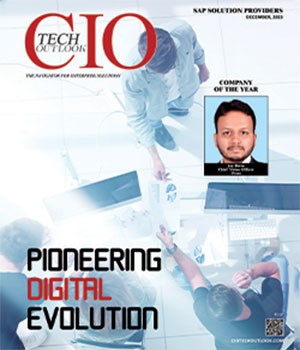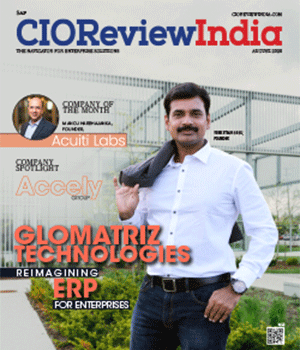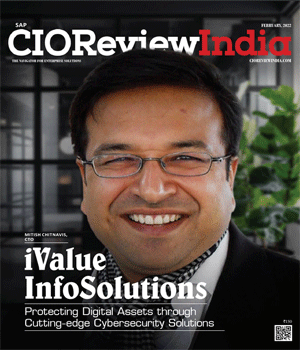
Future of Smart Manufacturing: Integrating Tech in Consumer Appliances
Mohammed Kaishulla, Chief information officer, EPACK Durable
 Mohammed Kaishulla, Chief information officer, EPACK Durable, in an exclusive interview with CIOTechOutlook, shares his views on how smart manufacturing is revolutionizing the consumer appliances industry, the role of additive manufacturing techniques in transforming consumer appliance industry, how companies adopt sustainable practices to reduce waste and energy consumption, the impact of smart manufacturing on supply chain management and more. He has over two decades of experience in manufacturing operations and product development.
Mohammed Kaishulla, Chief information officer, EPACK Durable, in an exclusive interview with CIOTechOutlook, shares his views on how smart manufacturing is revolutionizing the consumer appliances industry, the role of additive manufacturing techniques in transforming consumer appliance industry, how companies adopt sustainable practices to reduce waste and energy consumption, the impact of smart manufacturing on supply chain management and more. He has over two decades of experience in manufacturing operations and product development.
How is smart manufacturing revolutionizing the consumer appliances industry by introducing advanced technologies that enhance product performance and operational efficiency?
The introduction of artificial intelligence, IoT and automation technologies such as RQ has revolutionized the consumer application industry. Artificial intelligence's capability helps the manufacturer perform predictive analysis. For instance, having manufacturing plants globally across various regions makes it impossible for humans to forecast when machines fail. Hence, the predictive maintenance algorithm based on the sensor helps the manufacturer forecast it. When machines need maintenance, this will help reduce maintenance, increase production, and reduce production costs.
Another factor is quality. In the consumer industry, if we don't deliver quality goods, customers will not accept them. So, an AI-based power vision system helps inspect the product in real-time. For instance, While manufacturing an AC passes through a different line, a quality check is involved based on an AI algorithm. When it goes from one line to another line, it gets checked online. The defects are denied in real-time, and the defective goods are removed from production, which gives a higher quality standard and satisfies the consumer's demands.
Besides, supply chain management is critical in the manufacturing industry; if it needs to be addressed appropriately, it increases costs. So, an AI-based algorithm helps forecast demand. Based on demand, the minimum cost of inventory can be maintained, the minimum level of inventory can be maintained, and demand can increase. All these are possible with the help of artificial intelligence, which helps forecast and optimize the inventory level.
IoT is one of the other factors, and with its help, vast amounts of data are collected from different manufacturing machines. All data are processed and moved to a central location, where we analyze them. Then, improving manufacturing quality and processes takes more time as the process needs to be re-run. Hence, collecting data on various machines through IoTs helps manufacturers analyze and improve manufacturing processes.
Moreover, energy management is essential as it is one of the most expensive forms of energy, and smart sensors help reduce energy. Even consumer goods are supplied to those who want to meet a high standard. More importantly, with numerous consumer-efficient products, it is essential to reduce cost, which is possible by using IoT devices and smart sensors that help manufacturers produce more energy-efficient goods.
The other aspect is automation. In manufacturing, many repetitive activities need to be optimized. So, introducing RPA in manufacturing to similar activities is repetitive and doesn't require any human intelligence. RPA has taken care of such optimization, and introducing RPA in manufacturing helps reduce cost, efficiency, and human error.
Another factor is commerce, wherein the robots are introduced to provide 24{7} support, and the algorithm is written in such a way that the issue doesn't require human intervention and robots help to resolve it.
Finally, the integration. Having the data collected through the sensors in a centralized location is crucial and requires multiple hardware. The data is connected to the cloud with the introduction of cloud computing. Whatever they produce, they capture the data and go to the central cloud location, which can be accessed globally across an area. From there, they analyze this and perform the different manufacturing processes.
Sustainability is becoming a central focus in smart manufacturing, how are companies in smart manufacturing adopting practices to reduce waste and energy consumption, and what role does sustainability play in their strategies?
Sustainability is one of the critical components for any manufacturing industry to survive. If organization fail to make cost-benefit, sustainability and energy efficient, they cannot survive. Every product has a cost, a combination of various components, including raw workforce and material. So, energy efficiency should be there. In this current business landscape, firms cannot sell and have energy-efficient products while producing goods with high energy consumption. Even in the manufacturing sector, we need energy efficiency to do it. Smart manufacturing is the concept in which we can reduce and sustain costs by utilizing automatic sensors for maintenance quality.
The other is the operation. From the central point, we can control all the equipment, and by controlling it, we benefit from cost optimization. Besides, since we know the manufacturing side, they are located in the far remote, it is not possible for small things to go to the fair and so on. Hence, the IoT has to take control of those machines that are located in remote areas, fine-tune them, and rectify them. This way, they can survive sustainably and reduce costs, which is only possible with smart manufacturing. Hence, only IoT and AI-based technology will help them sustain the competition.
How are additive manufacturing techniques, like 3D printing, transforming the consumer appliance industry in terms of rapid prototyping and customization?
Prototypes are a critical challenge, and even similar industries have different prototypes. The prototype is highly customizable, and companies must invest a considerable amount to make a prototype that meets their requirements. However, it is costly, so many technologies are now involved, like edge computing, which helps companies adopt the prototype. Technologies such as 3-D modeling, 2D modeling, and surface scanning help reduce costs. Before the product is delivered to the consumer, analyzing how it will work is essential. So, by 3D modeling, we can explore the product's appearance before it is delivered to the consumer. And this will benefit both the consumer and the industry. They can analyze the product without making it, and the technology helps to reduce the quality rating and product failure. Hence, these techniques allow manufacturers to increase their productivity, reduce downtime, and provide a quality, efficient product to the consumer.
Smart manufacturing can enhance supply chain visibility, what potential impacts can smart manufacturing have on supply chain management within the consumer appliances industry?
First of all, let us have a clear picture of consumer manufacturing; it is seasonal-based manufacturing. For small appliances, products are in demand during the festival, so consumers are a seasonal industry, and every month has a different season and time. Manufacturing needs raw materials, and no manufacturer can maintain a vast inventory. The other aspect is service chain management; manually, it is impossible to control the service chain as it is globally procured and manufactured. So, procuring the same quality material but giving different data is crucial, and the IoT device has an activity to get real-time inventory data.
The other point is the shipment status. It is impossible to trace the shipment status, where it is manually, and under which conditions the shipment will arrive. So, most of the shipment industry has IoT devices within the shipment. So, the shipment will be in real-time, tracking the status, when it can arrive, and how the system maintains the temperature. By monitoring all this, we can reduce the downtime. Plan and forecast our planning when the system or material can be delivered. This can improve the supply chain management. Hence, IoT helps to maintain the supply chain by reducing the inventory level, giving the shipment status, and forecasting the demand.
How can manufacturers balance the need for innovation with cost considerations when integrating new technologies into consumer appliances?
In this business landscape, manufacturing is not a low-cost industry, and every technology has a cost. While taking the benefit of technology and delivering consumer satisfaction, there is a need for investment, and bandwidth investment will only reduce the cost. For instance, the introduction of IoTs generated a lot of data in different formats, bringing all data in a similar format to a central location analyzing it, and giving the output. However, it needs cost and is essential to adopt technology. Hence, the industry is looking for alternatives, and by edge computing, instead of sending all data to the cloud, the data is generated and processed where it was generated. This reduces the bandwidth and the cloud computing space. All the necessary data to be preserved is sent to the cloud.
The other aspect is standardization. Every industry has its standardization, and efforts are being made to meet it. The higher authorities are coming up with new laws considering the challenges, which will lower the cost of the manufacturing sector. When it comes to the manufacturing environment, the consumer appliances industry is customizable. Every consumer has their own personalization needs, and the introduction of AI captures the data and analyzes which types of goods are in high demand and whether goods are preferred by consumers. Hence, producing those goods will reduce the production cost and thereby also lower the cost and sustainability of the industry by increasing the production, reducing the wastage, giving the smart manufacturing contribution, linking all machines with the central location, removing all unwanted data that is not required to analyze, and reducing the downtime.
CIO Viewpoint
Upcoming Technological Advancements in Payments...
By Pinak Chakraborty, CIO of Airtel Payments Bank
Shaping the Future of AI: Talent, Innovation,...
By Yann LeCun, Chief AI Scientist at Meta
Future of Smart Manufacturing: Integrating Tech...
By Mohammed Kaishulla, Chief information officer, EPACK Durable
CXO Insights
Prasa: A Pioneer in Offering Precise Solutions...
By Jay Burse, Chief Vision Officer
SAP, the Digital Future Navigating Business...



.jpg)
.jpg)






